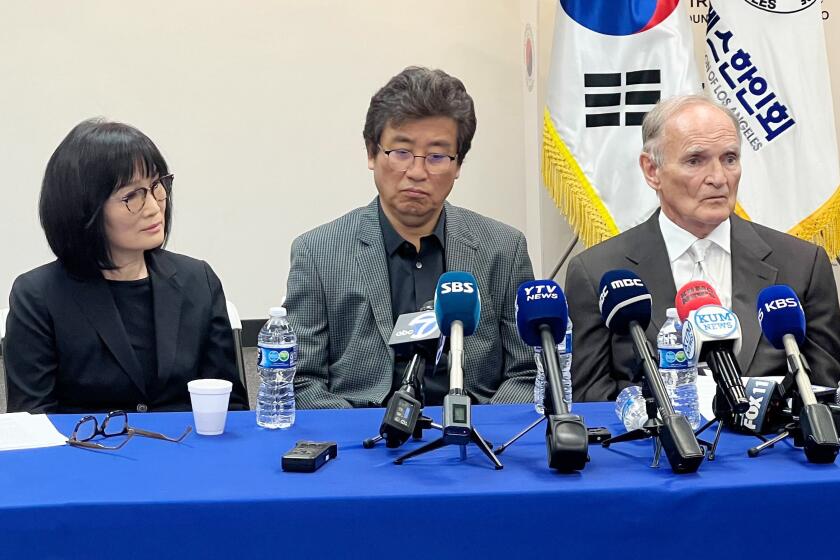Robot Brings Hospital Meals With Dispatch : Technology: With flashing lights and a voice warning workers to ‘stand clear,’ the $6-an-hour machine saves medical personnel from doing routine chores.
“I am about to move. Please stand clear,” the robot said in the kitchen of Downey Community Hospital. Wearing a name badge that identified him as “D.C. Dietary,” he was programmed to deliver food trays to a nurses’ station.
“He’s like any of my employees--he’s doing a job,” said Nancy Hipp, the hospital’s director of dietetic services, who punches in codes on D.C.’s computer screen that tell him where to go. “He has a personality, almost.”
The robot, who has been running errands at the hospital for two months, was leased not to replace people but to allow employees to do what they were trained to do, officials said.
Headless and without arms, D.C. does not completely fit the stereotype of a robot. With his white 4 1/2-foot-tall, 350-pound frame, he looks somewhat like a washing machine. His wheels are recessed behind wrap-around bumpers.
Equipped with a “backpack,” computer-controlled sensors, an internal map of the hospital and an infrared camera, he rolled along the corridors during a media demonstration Monday. His pace was slower than that of the average person who might deliver food, but D.C. never stopped to engage in conversations.
He even used the service elevator without assistance, selecting a floor through a radio transmitter.
If something was in his path, he would flash his gold warning lights, stop and say in his deep voice, “My way is blocked. Please move the obstacle.”
A patient who happens to get in D.C.’s way need not worry about being run over because the robot immediately stops, figures out what to do, then moves around the person.
“His vision and ultrasound proximity sensors allow him to understand the environment and avoid obstacles as they are encountered,” said Shawn Klotz, assistant director of engineering at the hospital.
Because D.C. can become an obstacle himself if doctors and nurses are racing to respond to a Code Blue (cardiac arrest), he has an emergency stop button. When that is pushed, he can be quickly wheeled aside.
Downey Community officials say the 207-bed, four-story hospital is only the second in the nation to use the trackless robot, which was developed by Transitions Research Corp. of Danbury, Conn. The other one is in Danbury.
Downey hospital officials saw the robot as a means to alleviate the dietary department’s problem of having to make special runs to deliver food requested after the regular mass deliveries.
The department did not have funds in its budget to hire someone strictly to deliver those trays, so an employee would have to leave his or her regular job to deliver them.
“My employees have accepted it extremely well,” Hipp said. “They were not fearful it would take their jobs. They were excited about it.”
D.C., who does not go into patients’ rooms, can deliver between 35 and 40 trays a day. He carries two at a time, but future modifications of his rear compartments will allow him to carry more.
“We end up paying someone a minimum of $6.55 an hour to go from point A to point B,” Hipp said. “Considering the amount of time and money it takes to train employees, and the salary and benefits paid to a full-time employee, it makes sense to invest in a piece of equipment like D.C.”
The hospital, which is leasing D.C. for $6 an hour, may eventually buy the $60,000 robot.
D.C., whose initials are derived from the hospital’s name, works most of the time for dietary. But in the evening he delivers prescriptions for the pharmacy department before being plugged into a battery pack for an eight-hour rest overnight.
He has become a favorite of patients, especially younger ones, said Lisa Domke, the hospital’s public relations coordinator. “Kids think it’s the greatest thing ever,” she said.
When the elevator door opened on the second floor Monday and D.C. got off, saying, “Please stand clear,” hospital visitor P.D. Howard of Norwalk was taken by surprise.
“I thought there was only humans here,” the man said. “It’s a peculiar-looking thing. I don’t know if I’d want it doing anything for me.”
‘D..C.Dietary’ A new high-tech device was unveiled this week at Downey Community Hospital. The self-guided, trackless robotic courier is used to deliver items from one area of the hospital to another without assistance from hospital personnel. Here is a brief look at the robot, called ‘D.C.Dietary’. Size: 36 inches by 32 inches by 55 inches tall Weight: 350 pounds Body composition: Steel and fiberglass Energy source: 24-volt battery Manufacturer: Transitions Research Corp., Danbury, Conn. Cost: $60,000 Special abilities: Utilizes vision and ultrasonic proximity sensors to evaluate its environment and avoid obstacles from point to point by using a map of the building to compute the best route. Independently uses elevators without human assistance. Source: Downey Community Hospital
More to Read
Start your day right
Sign up for Essential California for news, features and recommendations from the L.A. Times and beyond in your inbox six days a week.
You may occasionally receive promotional content from the Los Angeles Times.






